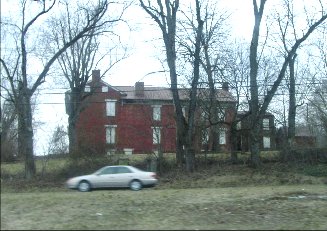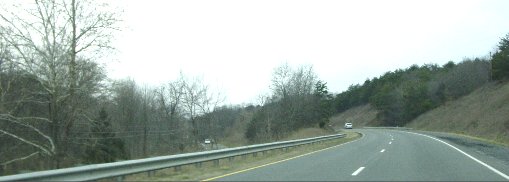
Third Winchester
September 19, 1864
Following Jubal Early's successful attack on Crook's army at the Second Battle of Kernstown south of Winchester in July 1864, Grant put Phil Sheridan in command of a reinforced and reorganized Army of the Shenandoah. Although he had a reputation as a fighter, Sheridan would take his time in attacking Early, possibly to avoid an embarrassing failure before the Presidential election. In September, after Sherman had captured Atlanta, Grant came up for a visit and urged an attack. Kershaw's division and an artillery battalion had left Early's army to rejoin Lee at Petersburg, so Sheridan had an excellent opportunity.
Sheridan's 39,000 man army was at Berryville, several miles east of Winchester, separated from Early's 15,000 men by the Opequon Creek. (pronounced Oh-peck-un) Early was actually concentrated at Stephenson's Depot several miles north of Winchester, with three of his four infantry divisions there to threaten the Baltimore & Ohio railroad, making his lines of communication vulnerable. Sheridan resolved to exploit the situation by moving quickly across the Opequon, then advancing into Winchester in order to cut off Early's escape south. With luck, the Confederate army would be destroyed.

Spout Springs Ford

|

|
Most of Sheridan's cavalry crossed further north and demonstrated toward Stephenson's Depot. But instead of crossing his infantry at several points and advancing over several roads, Sheridan used a single route, the Berryville Pike. The top photo is the view from the Confederate side of the crossing. Since high ground on the east side of the creek dominated the west side, it wasn't practical for the Confederates to defend the crossing directly. But the Berryville Pike was not an ideal route for an advance. Immediately after ford, the road made its way through a long ravine or defile, which constricted the advance and led to difficulties. This defile is called the Berryville Canyon, even though the term "canyon" isn't commonly used in Virginia.

Exit of Berryville Canyon
The Confederate defense began at the western end of the canyon. Here near the general location of the Eversole House, Wilson's cavalry had to fight its way out of the mouth of the canyon against Ramseur's division. This, and the fact that the VI Corps had its wagons directly behind it, served to delay the XIX Corps of Emory, then Crook's VIII Corps in reserve. With the Union army delayed for four hours, Early was able to understand his predicament and bring his army south from Stephenson's Depot to face Sheridan. The Union plan had miscarried, and a difficult fight was in the offing.
Across the Berryville Pike, in the area of the new school complex and to the right of it, was the First Woods. Sheridan's VI and XIX Corps began to deploy through the woods to attack the divisions of Gordon, Rodes, and Ramseur. The Union advance, though, would be confused.

Giant Trailer Park / Battlefield From Confederate Position
Having deployed near the modern school complex, the Yankees of Grover's division of Emory's XIX Corps with Dwight's division in support advanced generally along the axis of the modern power lines on the left of the picture, which are parallel to Red Bud Run off the picture to the left. Grover's Division was generally off the picture to the left, although at the time, the area of the advance was cleared of trees up until the Confederate position in the Second Woods. Part of Ash Hollow, I believe, is on right side of the picture. Beyond this, and not visible, Wright's VI Corps was advancing along the Berryville Pike. So the two corps were diverging slightly, and a gap developed in the area shown here. Although Grover pushed Gordon back through the Second Woods, a counterattack by Gordon and Rodes in this area - into Grover's flank - pushed the Yankees back. (Rodes was killed as the counterattack began.) Dwight's division of XIX Corps in support helped rescue Grover, and the fighting settled down into long range artillery fire. Sheridan would be forced to commit his reserve, Crook's VIII Corps.

Second Woods
For reference, the fence and power lines on either end of this panorama are the same as in the previous picture. The giant trailer park is off the picture to the right in the distance. So Union troops attacked along the axis of the fence on the right. At the time, though, much of this cleared area was the Second Woods, and these woods extended into the ripples of ground on the left of the picture between the camera and the modern Industrial Area behind I-81. By the end of the day, the Confederates would be pushed back to that area.
Hackwood was a prominent feature of the battle and would be used as a hospital. Hackwood Lane is visible as a thin tree-line in the center of the panorama. The Confederate left ended near the Lane.

From Hackwood Lane
This is the view from the opposite side of Hackwood Lane, beyond the left of the Confederate infantry line here. The lane pivots northward on the far left of the picture and heads toward Red Bud Run. The Union XIX Corps advance was along the axis the Lane from the right.
Crook's VIII Corps had been in reserve. With Union attacks repulsed, one of Crook's divisions under Thoburn continued the attack in this area south of Red Bud Run. Meanwhile, in order to flank the Confederate line, Duval's division crossed to the north side of Red Bud Run near the modern school complex that we've seen previously and advanced into the area visible in this center distance of this picture, pushing back Breathed's horse artillery. Now, Duval would re-cross the creek and attack the Confederate flank.

Red Bud Run Crossing
|
 |

Red Bud Run Near Hackwood
This is the view from a bridge over Red Bud Run on the one-laned road down to Hackwood, visible on the right. The stone building on the far left is a local drinking water facility. In short, I may or may have been trespassing by driving down this road, so don't make this part of your travel plans.
There is a good view of part of the battle area, with the site of the Second Woods atop the hill visible above the water.

Ft. Collier
|

|

Looking South From Ft. Collier
The entrenched Confederate line behind Ft. Collier was beyond, and roughly parallel to, the road visible on the right-center of the picture, in an area which is now an industrial park. The line extending to Star Fort on the distant ridgeline on the right of the picture.
The Union cavalry attack continued into the Confederate lines, penetrating them and putting the whole Confederate army to flight. Many prisoners were taken, including the webmaster's 2nd great-granduncles William and George Washington Martin of Company A, 23rd Bn. Va. Infantry, who were sent to Point Lookout, Maryland.
The battle was a Union victory, but it wasn't nearly as decisive as it could have been. Sheridan infantry column had not cut off Early's retreat as planned, and the final decisive cavalry attack from the north hadn't either. In this hard fought battle Sheridan lost around 5,000 of his 39,000 men compared to Early's 3,600 lost from an army of 15,000 men. Although not destroyed, Early's Confederates were reduced in number, and their morale suffered. Three days later, Sheridan attacked Early's position across the narrowest part of the Valley at Fisher's Hill, routing him once again. The Yankees pursued up the Valley, but Sheridan decided against trying to force his way across the Blue Ridge and instead fell back to Cedar Creek, burning anything useful to the Confederates along the way. Pursuing, Early's outnumbered army attacked the Yankees at Cedar Creek in October and nearly defeated them.
Back to Civil War Virtual Battlefield Tours